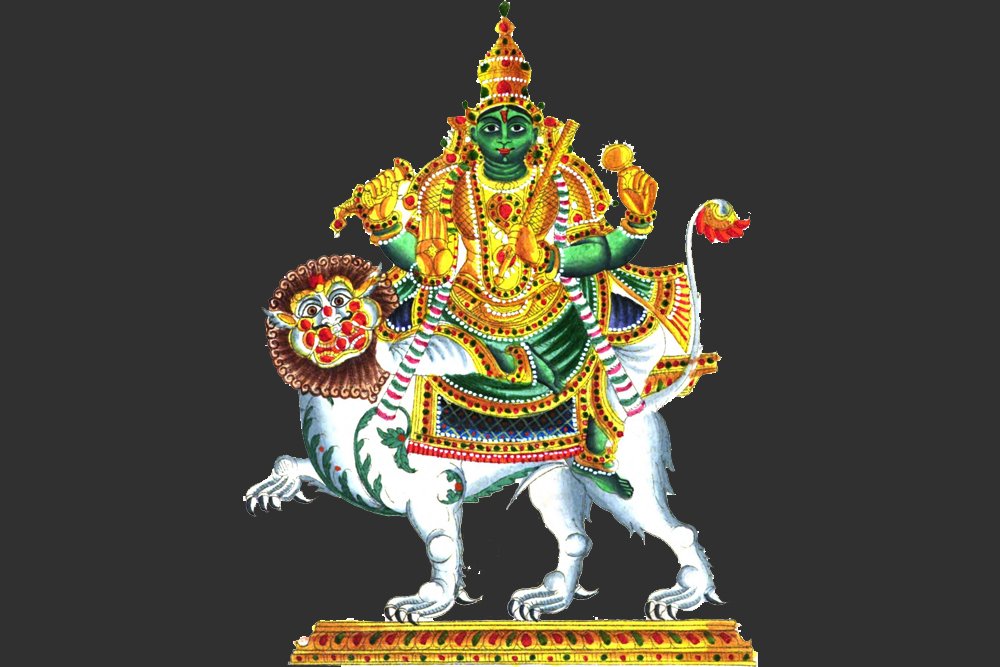Mercury is known by the name Budha. He is Chandra’s (Moon’s) son. Additionally, he is the god of products. He is depicted as being mild and having a complexion that is greenish. He is depicted riding a lion with wings and holding a shield. He rides a carpet or a lion-drawn chariot, holds a sceptre and lotus, and is depicted in other illustrations. Wednesday is overseen by Budha. Ila, Vaivasvata Manu’s daughter, is his wife.
The God of intelligence, communication, art, wit, and humor is Budha. Additionally, he is merchants’ protector and merchandise god. The nervous system is governed by the planet. On Wednesday, the best way to get Budha’s blessings is to worship him.
Budha is the name of the moon god Chandra’s son. Most of the time, he is shown with four hands. Three of them are holding a mace, shield, or sword, and the fourth one is giving blessings. He travels on an Eagle or Lion-drawn chariot.
Budha is regarded as a giver of happiness and intelligence in the sacred text Budha Ashtottara Shatanamavali, which contains 108 names of Budha. In the text, he is praised as the God who can treat all diseases.
Budha is praised as the best planet in the sacred text Budha Pancha Vimsathi Nama Stotram. It praises Budha as the wisest of all and the giver of wealth and knowledge.
It says that devoted Budha worship can bring blessings for cattle wealth, grains, and offspring. In addition, it states that Budha is the God of the Stars and has the ability to thwart enemies’ evil deeds. Budha’s appearance is compared to Lord Vishnu’s, one of the Trinity, in the text.
In the revered Budha mantra, Budha is praised as an illustration of intelligence. The text praises God’s attributes as the most beautiful.
Budha is depicted as kind and pious in the holy book Budha Kavacham. The text also praises Budha as a health guardian who protects people from all kinds of sickness and pain. Reciting or hearing the chants is also believed to guarantee victory.
The Swetharanyeswarar Temple in Thiruvenkadu, a village in the Mayiladuthurai district of the South Indian state of Tamil Nadu, is a Hindu temple dedicated to the god Shiva. The lingam serves as a symbol of Shiva, who is revered as Swetharanyeswarar. Brahmavidyambigai is portrayed as his wife Parvati. In the Tamil Saiva canonical work Tevaram, which was written by Tamil saint poets known as the Nayanars and is categorized as Paadal Petra Sthalam, the presiding deity is praised. As one of the temples associated with the nine planet elements, the Navagraha Stalas, and specifically Budha, it is significant to the Hindu sect of Saivism.
People pleaded with Shiva to end their suffering. Under a tree that is believed to be the location of the Thiruvengadu temple, Shiva incarnated as Agoramurthi and killed Maruthuvasuran. Other names for the location include Swetaranyam, Adi Chidambaram, and Nava Ntirya Stala. Here, Swetharanyeswarar is said to have been worshipped by Indra, Budha, Surya, Chandra, and Airavata.
The main entrance to the approximately two-acre temple complex is a seven-tiered gopuram. There are several shrines in the temple, the most prominent of which are those of Swetharanyesarar, Aghora, and Nataraja. The temple has large, concentric, rectangular granite walls that surround all of the shrines as well as the three temple tanks.
From 6:00 a.m. to 8:00 p.m., the temple has six daily rituals and four annual festivals on its calendar. The most important festivals celebrated in the temple are Chitra Pournami and Aani Thirumanjanam in the Tamil month of Aaani, which runs from June to July.
It is believed that Cholas constructed the original complex, while Vijayanagar kings constructed the current masonry structure in the 16th century. In the modern era, the Hindu Religious and Charitable Endowments Department of the Government of Tamil Nadu is in charge of the temple’s administration and upkeep.
Nandi sits at the entrance to Devi’s shrine and has nine scars on its body. It is said that Budhan grants intelligence and wisdom to the Nine Planets. It is believed that resolving Bhuda Dhosham is accomplished by performing puja on Wednesdays. By going to the temple, people can get rid of puthira dosham, problems in school, mental instability, and nervous disorders. Bhudan’s advantages include knowledge, music, medicine, and language skills.
Achyutha Kalappalar, a local chieftain, was, according to Hindu legend, childless. Sivacharya, his guru, looked at his horoscope and read from an old palm leaf manuscript. It contained the verse of Sambandar, one of the most important Nayanar Saivite saints. In order to be blessed with children, the chieftain was instructed to pray at Venkadu. Together with his wife, he prayed there, and they had a boy. Meykandadevar, the boy, later wrote Sivagnana Bodham.
Budha, according to Hindu myth, was the child of Chandra and Tara. Originally Brihaspati’s wife, Tara had an illicit relationship with Chandra. Shiva and Brahma told Tara to go back to her husband Guru, so she gave the child to Chandra. When Budha learned about his upbringing as a child, he began to despise his parents. He severely repented by praying to Shiva. Shiva blessed him to be a Navagraha for his devotion. In the temple, goddess Parvathi bestowed the divine power of learning (Vidya) upon Brahma. It is believed that the idol Pillai Idikki Amman depicts Parvathi holding the child Sambandar when the latter referred to her as Amma.
In addition, it is believed that Lord Vishnu is associated with Bhudan, so he should be worshipped every Thursday for some relief. The Bhudangayatri mantra is a set of mantras that must be chanted in addition to these pujas. The mantra is effective when chanted about 108 times per day.

